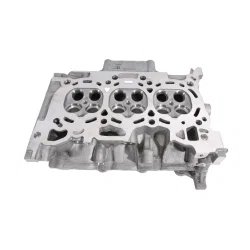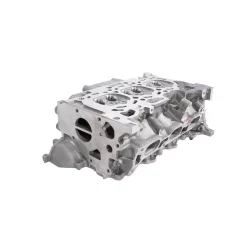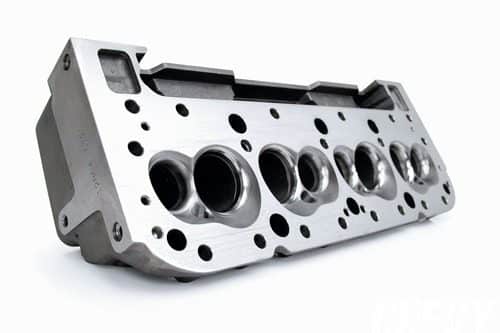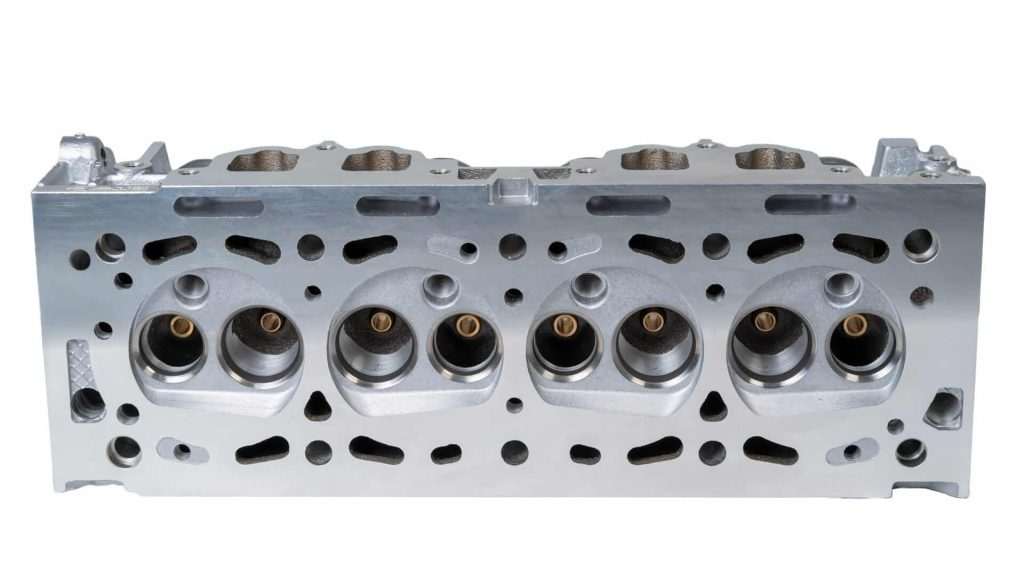Cylinder head



The car cylinder head and its components
The car cylinder head is one of the most important, most used, most vital, most sensitive, and at the same time, most expensive parts of a car, so it is necessary to have a relative familiarity with this large and expensive piece. The car cylinder head is the name of a large piece that is located at the top of the cylinder block and its main and very important task is to insulate the engine and cylinder and prevent the escape of gases from the cylinder chamber.
In most engines used in common cars, the top of the cylinder is closed and insulated with a separate casting piece called the car cylinder head. The cylinder head is screwed to the top of the cylinder block. This joint is covered by a gasket called a cylinder head gasket to fully insulate. The cylinder head consists of a combustion chamber, spark plugs, camshafts, valve gates, valve seats, valve stem and springs, water and oil passages, manifold, exhaust claw and fuel inlet pipes into the cylinder and the thermostat closing place (in internal combustion cars).
In most engines, the car cylinder head includes passages that deliver air and fuel to the cylinders and allow the exhaust gases to exit. The cylinder head is usually made of gray iron or aluminum alloy to have sufficient and necessary durability and flexibility under harsh conditions and high temperature and pressure. Aluminum has advantages such as light weight and high thermal conductivity.
Components of the car cylinder head
The components of the car cylinder head are as follows:
- Cylinder head gasket
- Input and Output Ports
- Input and Output Valves for Gases and Liquids
- Combustion Chamber
- Candles
- Fuel Injectors
- butterfly stroke
- additional car cylinder head parts

Cylinder Head Gasket
This gasket is placed between the cylinder head and the engine block. Its function is to seal the engine and prevent the mixing of water and oil. The cylinder head gasket is screwed on top of the engine compartment. These gaskets act as a seal between the cylinder head and the engine block. This prevents leakage or mixing of oil and coolant. It also helps improve the operation of the oil filter in the vehicle.
Intake and Exhaust Manifolds
The intake and exhaust valves are part of the cylinder head. The intake valve (air manifold) is for circulating air into the cylinder head and combustion chamber. After the combustion process, gases are expelled by the exhaust valve (exhaust manifold) from the combustion chamber. These valves prevent the creation of internal pressure that could lead to engine explosion.
Car Valves
An engine has valves for closing and opening the intake and exhaust paths, with the aim of stopping or preventing the entry of air and fuel into the combustion chamber. In an internal combustion engine, each cylinder has two valves, the intake valve is usually larger and the exhaust valve is smaller. The valve lifter / rocker arm and valve spring are also part of the valve assembly.
Combustion Chamber
The combustion chamber of the cylinder head, also known as the engine core, is where the air and fuel mixture burns to generate the power to move the vehicle. Combustion chambers, depending on the engine design and its application, are designed in different shapes and sizes.
Car Spark Plug
The spark plug delivers electricity to the combustion chamber to ignite the air/fuel mixture. Spark plugs are installed on the cylinder heads and their tips lead directly into the combustion chamber. Spark plugs are usually screwed in to ensure air tightness and sealing.
Car Injector
Fuel injectors are also located on the cylinder head cover. In diesel engines, injectors inject fuel into the combustion chamber via a pump. When the car is started, before the gasoline is drawn towards the injector, it passes through a fuel filter to ensure clean fuel flows towards the engine.
Cylinder Head Camshaft
The cylinder head includes a camshaft. The camshaft is for opening and closing the valves. The crankshaft is a part of the engine block that uses a belt to move the cylinder head camshaft.
Additional Cylinder Head Parts
The cylinder head also has valves for lubrication and cooling the engine. The design of the cylinder head valves varies just like the designs of the cylinder head itself. Diesel engines also have parts such as a vacuum pump and an injection pump.

Cylinder Head Function
The cylinder head plays a crucial role in a motor vehicle. The structure of the cylinder head is complex and consists of many ports. The presence of the cylinder head and its specific design allows for the installation of various components such as valves, intake and exhaust channels, spark plugs, fuel injectors, and camshafts. In addition, it provides a safe and separate path for the movement of coolant, oil, and combustion gases.
The cylinder block absorbs the heat produced by the engine, thereby preventing engine damage and explosion. The cylinder head seals the combustion chamber and acts as the mechanical control powerhouse of the engine. It is responsible for providing electrical energy for the combustion of the fuel/air mixture in the engine, a task performed by the ignition coil. It also eliminates compression resulting from combustion pressure. Therefore, without a doubt, the cylinder head is one of the most sensitive and valuable parts of any engine and any motor vehicle.
Designing a cylinder head with four different designs
In general, types of cylinder heads are designed and built in the following 4 states based on the number and arrangement of valves:
I Head Cylinder Heads: I head cylinder heads are installed on small engines that provide enough power and density to provide propulsion with their small chamber. The design of I head cylinder heads is based on the number and type of valves and is such that they have one or two rows of ports for placing the valves. In this type of cylinder head, the air and exhaust manifolds are arranged linearly next to each other.
T-head cylinders: As the name suggests, in this type of cylinder head, the air and exhaust manifolds are located on both sides of the cylinder and have the maximum distance from each other.
L-head cylinders: In this design, the smoke and gas valves are located on one side of the cylinder; however, like the T-head cylinder design, they do not establish a connection with the inside of the cylinder.
F-head cylinders: In this design, the gas valves are located on the cylinder head, while the smoke valve is installed on the body of the cylinder head.
Advantages of using aluminum alloy cylinder heads:
Car cylinder heads are made of different materials, but the best type is designed from aluminum alloy. The advantages of using aluminum alloy cylinder heads are as follows:
- Higher thermal conductivity, which is about three times that of iron
- Lightweight
- Increased compression ratio without more explosion due to thermal conductivity
- Better cooling during engine operation
- Higher output power and less fuel consumption due to increased compression ratio and better cooling effect
- Faster engine warming
- Possibility of using a smaller radiator
Also, the disadvantages of using aluminum alloy car cylinder heads are as follows:
- Higher engine design cost
- Low modulus of elasticity
- Due to higher thermal expansion, a greater distance between the piston and the cylinder is required
- More likely to corrode by coolant
- Sometimes it is necessary to use an iron valve seat and plug
- Possibility of car cylinder head sticking to the cylinder due to corrosion
For the import of various types of spare parts, including spare parts for domestic and foreign cars, contact Tata Trading Company. Our connection with various companies around the world enables us to provide you with the best and highest quality spare parts from different brands, bringing you a profitable and easy trade.

